Comfort and discomfort during smartphone use on a bed
Abstract
BACKGROUND:
The number of smartphone users is immense. People can do ever more with a smartphone. Smartphones are used everywhere, including in bed and on the sofa. The awkward postures taken in these situations affect comfort and discomfort. In designing a bed, it might be useful to know which position is comfortable for smartphone use on a bed.
OBJECTIVE:
The objective was to define the most comfortable trunk angle for smartphone use on a bed.
METHODS:
To study comfort and discomfort, 52 participants were asked to use the smartphone on a bed. The trunk angle of this bed was adjusted to 6 positions from flat to upright and for each angle the comfort and discomfort was recorded.
RESULTS:
The results showed that the participants prefer a trunk angle range around 120 and 142 degrees. At the best trunk angle 29% of the participants felt comfort in the legs, 25% in the upper back and 16% in the shoulders. However, in this position 36% also mentioned discomfort in the lower back and 24 % in the neck.
CONCLUSIONS:
For smartphone use a bed is preferable which enables a trunk angle of around 120–140 degrees. For the legs this is comfortable. However, for the neck and upper back the problem of discomfort still needs attention.
1Introduction
In 2018, 40–50% of train passengers used their smartphone at the moment they were observed [1]. This is an enormous increase compared with observations using the same method in 2011 [2]. In the recent study 5% were listening to music, other tasks were watching a movie or series, texting, web browsing, checking email or the train time schedule. In marketing and research much attention has been paid to optimizing the systems and mechanisms of smartphones to increase productivity, for example [3, 4]. New versions of smartphones are often introduced in the market. The number of iPhones sold from Q3 2014 to Q3 2018 is 40 million per quarter as reported by Apple Worldwide [5]. Presumably, newer models have more features, which may stimulate users to use the smartphone even more. The relationship between smartphone comfort and body posture is seldom mentioned. Yet improving posture might be more effective in increasing productivity than introducing new smartphone features. Vink [6] showed that improving posture to fit the task can improve productivity. People use a smartphone in many locations, for example on the sofa, in conference rooms, in the work place, or on the bus, train or airplane [7]. And they use it in bed: in Honan’s 2015 US study, 50% of respondents reported frequently using the smartphone in bed [7]. This might be an issue as it may lead to uncomfortable postures. However, some beds are adjustable and can be inclined. The Semi-Fowler’s position is used in hospitals, in which the upper part of the bed is raised 30 degrees, resulting in a position where the trunk is raised 30 degrees. The Semi-Fowler’s position has been shown to be more effective than a supine position in hemodynamic stability of patients with head injury [8]. In designing the bed in a new aircraft (the Flying V, see Vink et al. [9]) where smartphones could be used, we found a gap in knowledge of which angle for the trunk support passengers prefer for smartphone use. This knowledge might be relevant in other areas as well such as submarines, trains or capsule hotels where smartphone use in bed might be increasing.
The research question is: what is the best trunk support angle for comfortable smartphone use on a bed? A flat position might give too much strain in the neck due to bending of the neck, and a fully upright position might result in too much stretching of the back or hamstring muscles. This paper aims to identify the appropriate trunk position for smartphone use on a bed.
2Materials and methods
To answer the research question “what is the best trunk support angle for smartphone use on a bed?”, an experiment was performed.
2.1Participants
30 men and 22 women of different nationalities (European, American, and Asian), all of higher education, participated in the study. The lengths of the participants varied from 153 to 197 cm. The average stature was 175 cm and the age between 22 and 30 years.
2.2Protocol
The research started with the introduction of the experiment and signing of an informed consent. Four research staff instructed the participants and checked whether the groups followed the protocol. The participants were separated into 13 groups of 4 persons. In the first 15 minutes, the 1st person of each group settled on a sunbed and took 6 positions (different back rest angles 177, 162, 142, 120, 99, 75 degrees as these are the angles of the sunbed). The participants used their own smartphone for some tasks they could define themselves, and at the end the answered an online questionnaire while still on the bed. The 2nd person was the time keeper who managed the timing of the experiment and adjusted the reclining mechanism. In each position, which lasted a few minutes, the research staff sent a message to the time keeper who then asked the 1st person to score their comfort in an electronic questionnaire on a smartphone. Also, questions regarding discomfort were completed. A 3rd person took a lateral picture of the 1st person to check their posture. The 4th person of each group managed the whole process and checked if everything is done right. All four participants of each group took all positions and experienced all angles. 26 participants were asked to start with the flat position (177 degrees), and the other 26 were asked to start in the upright position (75 degrees). Research staff (4 persons) instructed the participants, checked whether the groups followed the protocol and also sent reminders to the timekeepers.
2.3Questionnaire
An online questionnaire was used to evaluate each angle of trunk support. Each participant was asked to rate their comfort on a 7-point Likert scale (1 = no comfort at all and 7 = extreme comfort). A 7-point Likert scale was also used to assess discomfort which was adapted from Grinten [10]. After scoring each position each participant was asked to take up the most comfortable position and scored the areas of their body with the greatest discomfort using numbers on a body map, shown in Fig. 1. The area with the most comfort was elicited after that. The participants were able to select more than one body part for both comfort and discomfort.
Fig. 1
A body map on which to score (dis)comfort.
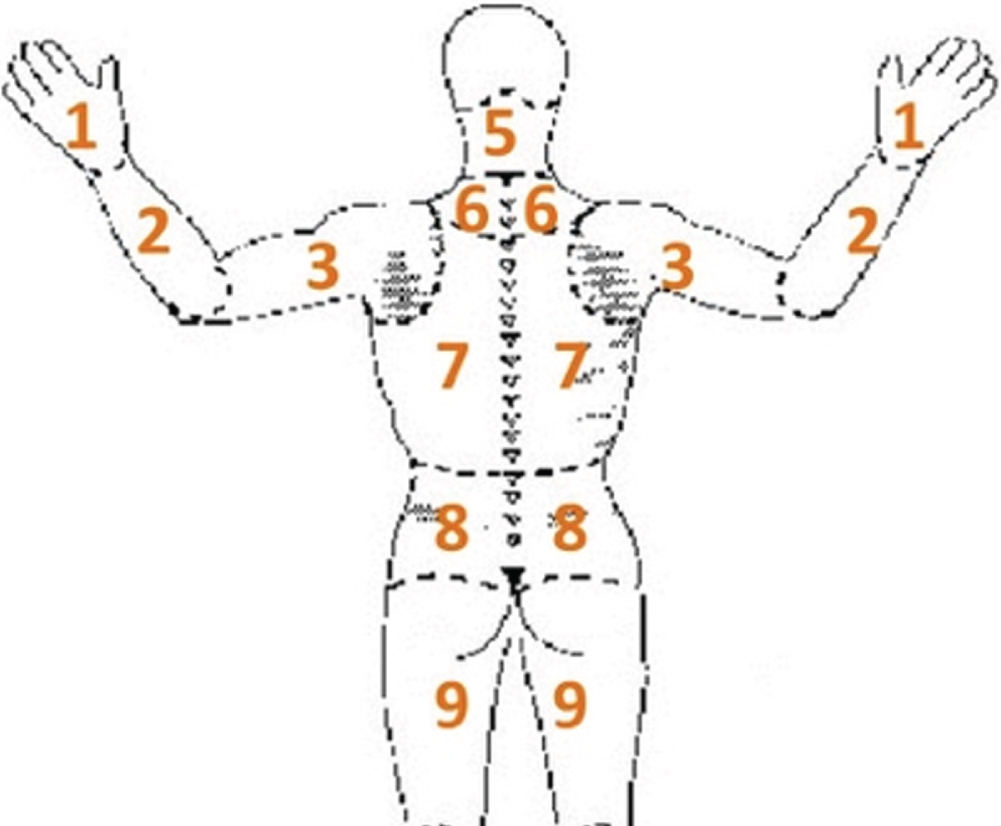
2.4Analysis
The analysis consisted of calculating the mean and standard deviation of the comfort and discomfort score plotting these data on a graph for each angle 177, 162, 142, 120, 99, 75 degrees respectively. An Independent-Sample Kruskal-Wallis test was used to compare the participants’ comfort during smartphone use at each angle. With this we could answer the research question into the best trunk support angle for smartphone use on a bed. The data in the body map showed the percentage of people mentioning comfort and discomfort in the different regions as calculated. This served to get an impression of where comfort and discomfort is experienced. It was also tested whether the hand position with which the participants used the smartphone was related to the preferred position.
3Results
3.1Results for the back support angle
All 52 participants used the smartphone with 6 different backrest angles. For 26 participants, the order of angles was 177, 162, 142, 120, 99, 75 degrees, and for the other 26, it was from 75 to 177 degrees. The angles are shown in Fig. 2.
Fig. 2
The different angles at which the participants used the smartphone.
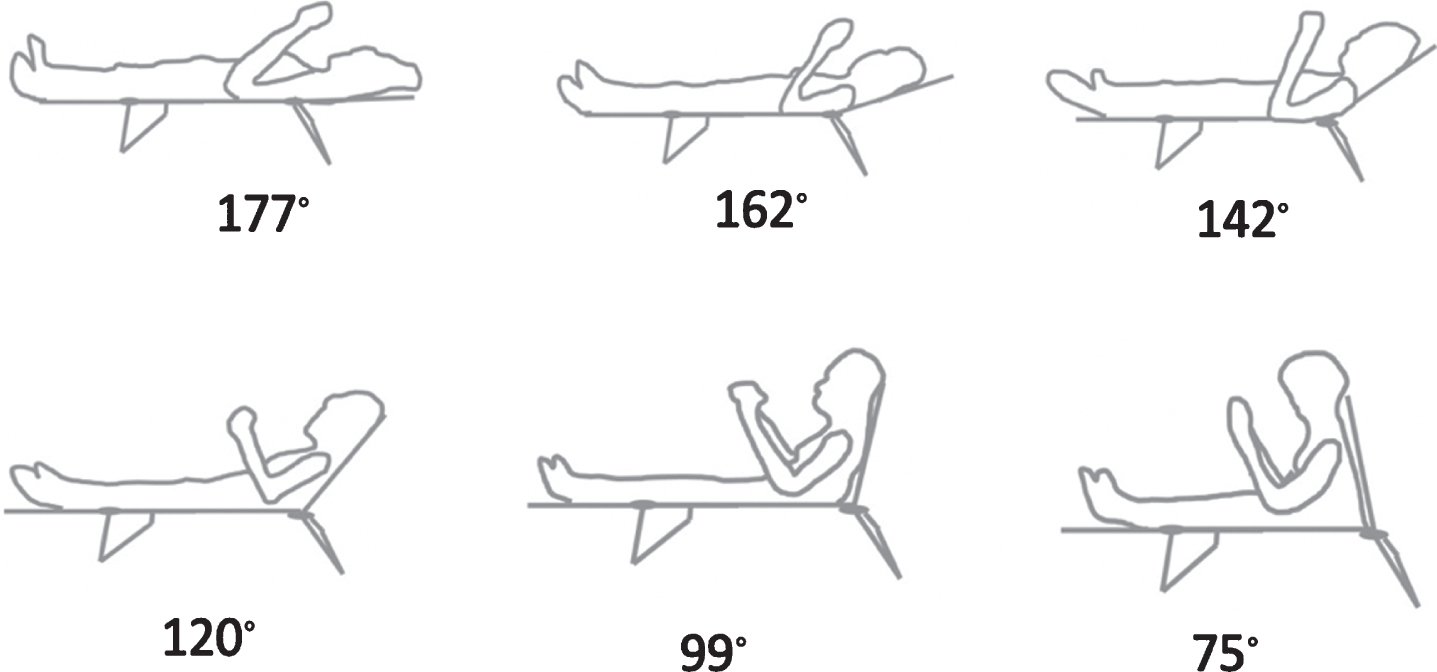
The comfort results (Fig. 3) were analysed using an Independent-Sample Kruskal-Wallis test. This method is a non-parametric test that can be used to compare two or more independent samples of equal or different sample sizes. It compares the median between the groups of data for different conditions. In this case the sample sizes were always the same: all participants tested all angles, in different orders to control for order effects. The samples were the participants, and the conditions were the angles. The results showed that the angles of 142 and 120 degrees differed the most from all the other angles. The participants reported greatest comfort in these angles. There was no significant difference between these two angles. The next preferred angles were 162, 177 and 99 degrees. These again did not differ from each other, but they did differ significantly from the 75 and 142 and 120 degree angles. Average comfort levels were rated at 4.8, 4.8, 4.4, 3.3, 3.2 and 1.8 respectively (an extremely high comfort level is 7, and no comfort at all is 1). Based on these data the answer to the research question regarding the best trunk support angle is that the users prefer the area between 142 and 120 degrees.
Fig. 3
Comfort levels separated by angle of back support.
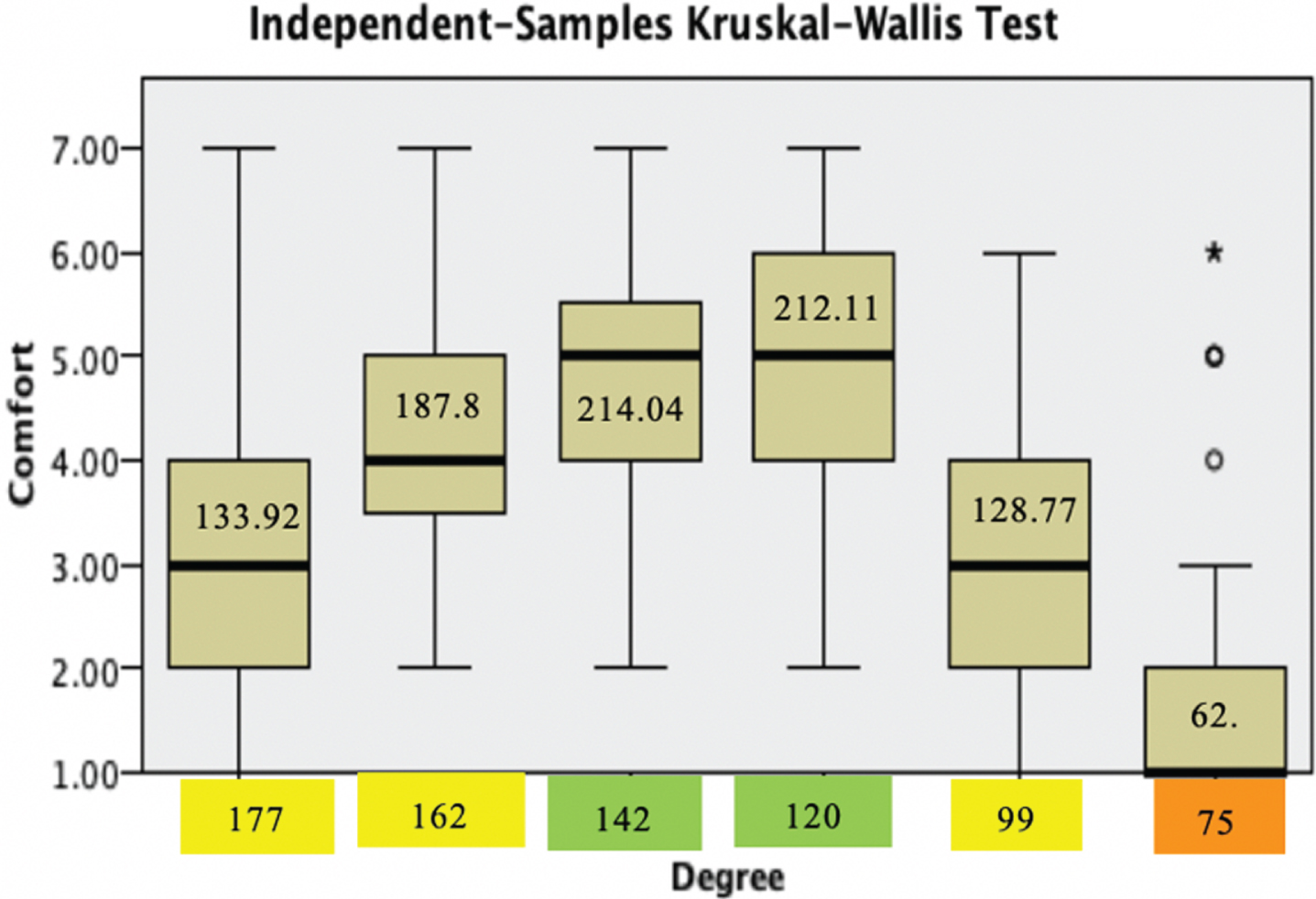
The preferred angle given by the 52 participants is shown in Fig. 4. Some participants preferred a number of angles, but among them too, 120 and 142 are the preferred angles.
Fig. 4
The number of participants voting for a specific angle.
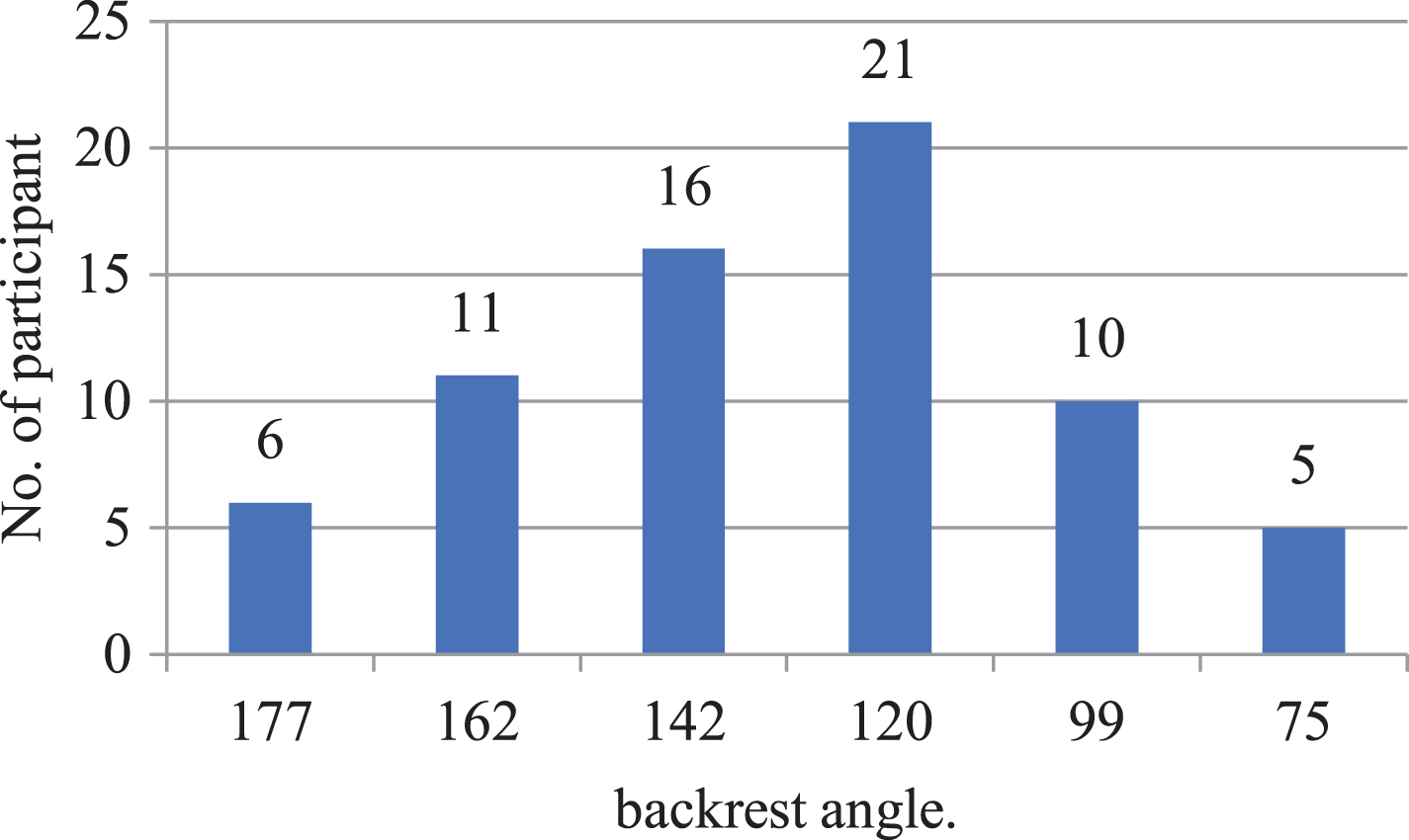
3.2Results for (dis)comfort felt by body region when the participants take the best of the six positions
When the 52 participants were in their preferred position, 29% felt most comfort in the legs. The percentages of participants that felt comfort in the upper back and shoulders region were 25% and 16% respectively. The percentage reporting comfort for the other regions was lower. 0%, 3%, 6% and 8% felt comfort in the hand, lower arm, lower back and neck respectively when using the smartphone on a bed (see Fig. 5).
Fig. 5
The percentage of participants reporting comfort for the different regions.
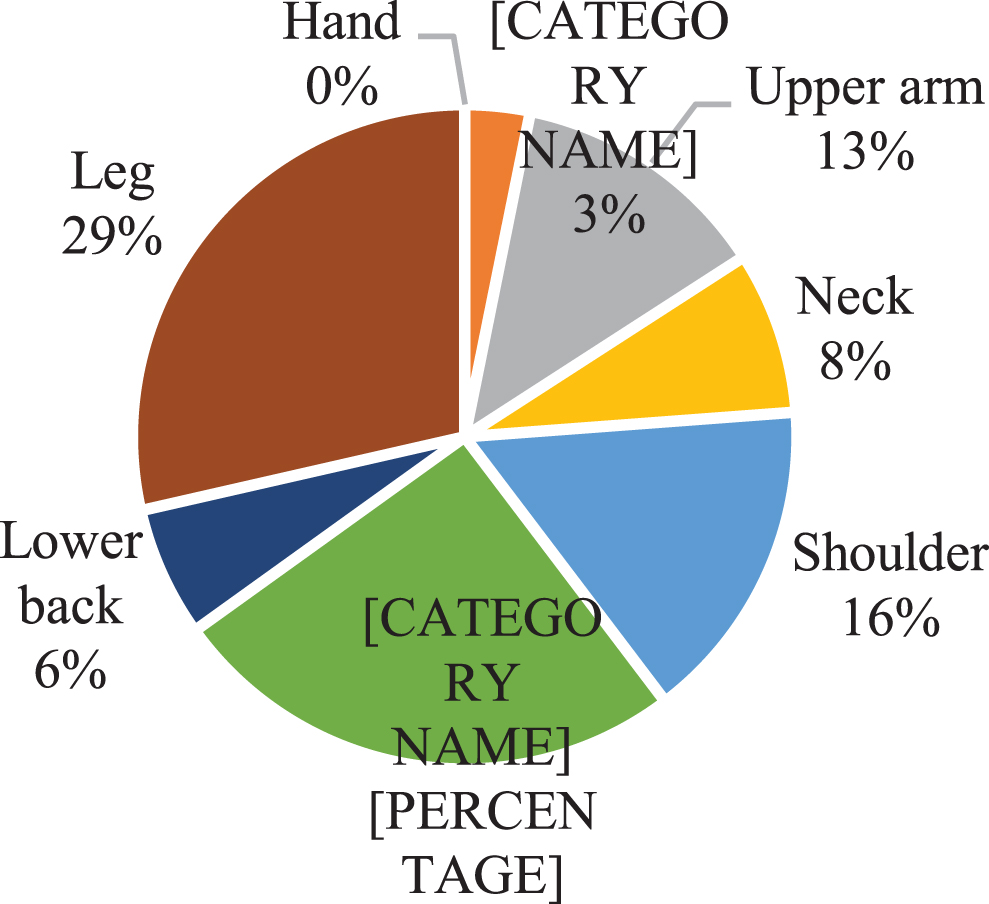
Discomfort for the best out of the six positions was highest in lower back and neck. 36%, 24%, 10%, 9% and 8% of the participants reported discomfort in the lower back, neck, upper back, shoulder and lower arm, respectively. The number of persons reporting discomfort in the hand, upper arm and leg while using the smartphone on a bed was low (<6%) (see Fig. 6).
Fig. 6
The percentage of participants reporting discomfort for the different regions.
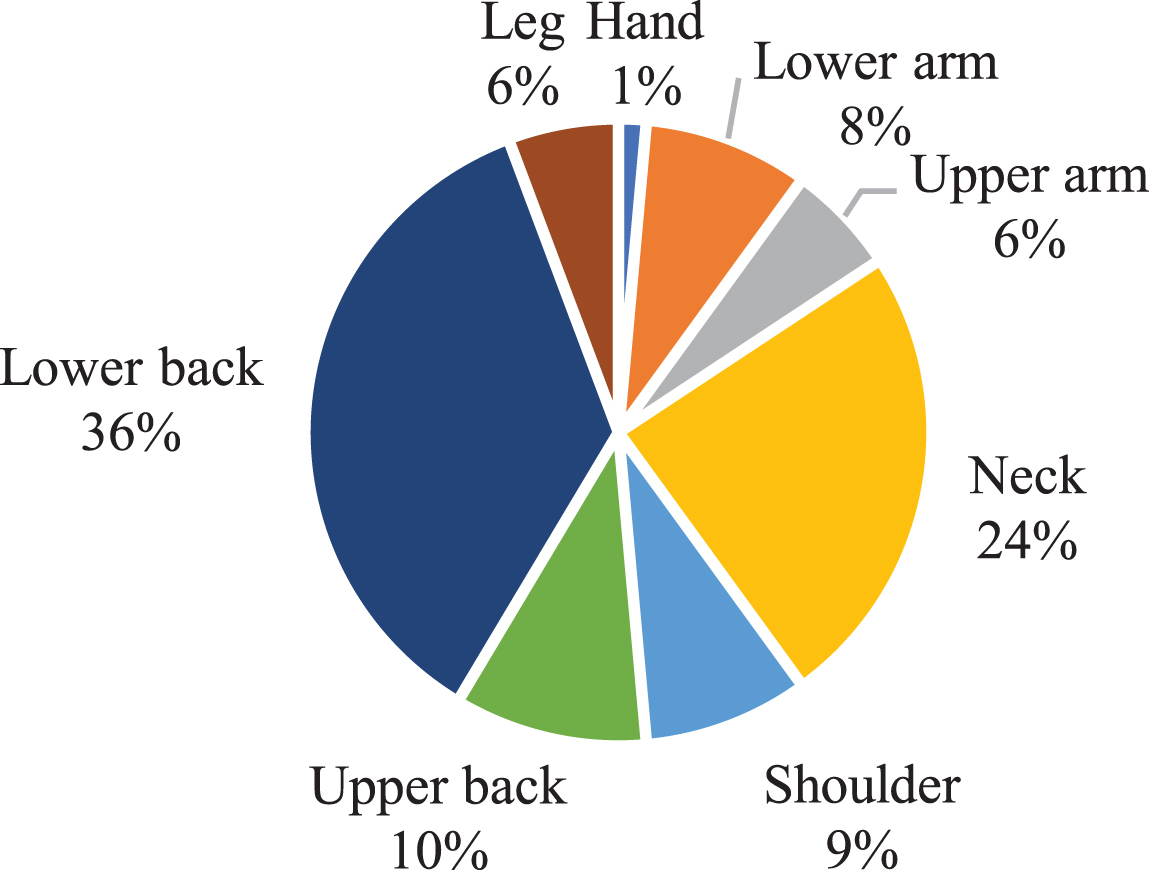
3.3Results for hand position during smartphone use
Figure 7 shows that most of the participants preferred to use the smartphone with two thumbs (63%). 31% mention that they operate the smartphone using only one finger. 6% of the participants used the smartphone in a different way. There were no significant differences between using a smartphone with two thumbs or one finger for each of the different trunk angles.
Fig. 7
Results of hand position during smartphone use.
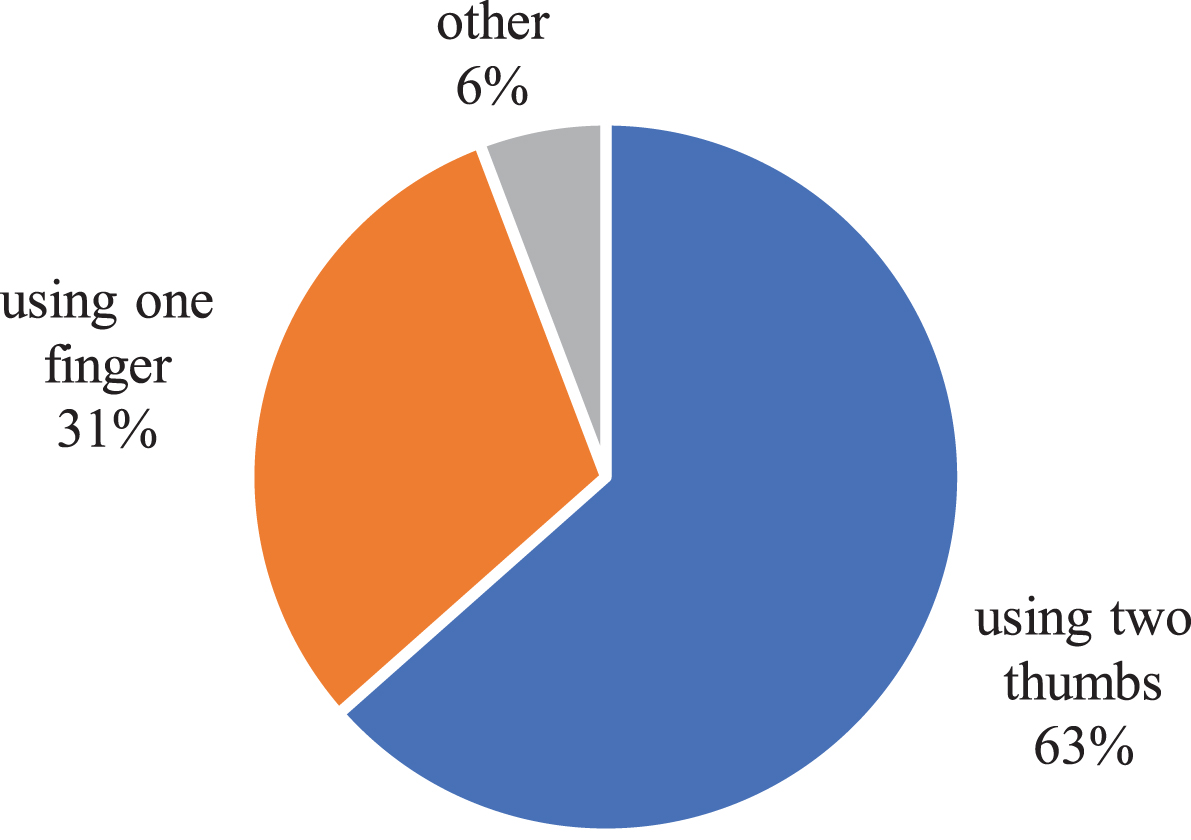
4Discussion
In answering the research question “what is the best trunk support angle for smartphone use on a bed” it is clear that there is not one preferred angle, but a range of angles in which the comfort is higher. The participants experienced high comfort when using the smartphone in a bed around a 142 to 120 degrees of backrest angle. Groenesteijn et al. [2] mention that an adjustable backrest is preferred so that the support can be adapted to the characteristics of the human and the task. They found a preferred backrest angle of 132 degrees for reading in an office chair. Of course, this is not lying on a bed, but the results show similarities. Probably the position of the arms and neck play a large role in determining the most comfortable back rest angle. This certainly needs further research. Of all participants, 35% report comfort of the legs in this position and 27%, and 19% felt comfort in the upper back and shoulders. The discomfort recordings showed that 36% and 24%, of the participants felt discomfort in the lower back and neck, respectively. It is clear that the leg position is comfortable. Rosmalen et al. [11] report that while watching television people like to have the feet off the floor and at a higher level. Probably humans like to have the feet off the floor or the legs at a level not much below the pelvis, and this may have contributed to comfort in our study too. Cicolini et al. [12] found a progressive decrease in blood pressure rates when the body position changed from sitting to the Fowler and from Fowler to the supine position. It appears that having the feet at a higher position is not only more comfortable but also decreases blood pressure. Possibly there is a relationship.
A problem that still needs to be solved in the ‘best’ position is the discomfort in the lower back and neck. Lower back discomfort might be caused by the fact that the bed gives no support there or because of stretching the hamstrings. The neck discomfort is probably caused by neck flexion, which has been found in other studies as well, for example [13]. A shortcoming of our study is that the participants only used the smartphone for a few minutes. It could be that longer use leads to other preferences. Sammonds et al. [14] and Smulders et al. [15] showed that sitting longer in one position leads to higher discomfort ratings. This might be true for the supine position or Semi-Fowler position as well.
5Conclusion
Regarding the research question “what is the best angle of trunk support for smartphone use on a bed”, the 52 participants preferred a trunk angle around 142 to 120 degrees. Especially the leg position is comfortable, but a reasonable percentage of participants also experiences upper back comfort. The participants prefer this angle but still have some discomfort. More than one third experiences discomfort in the lower back and a quarter discomfort in the neck, which still might need attention.
Conflict of interest
None to report.
Acknowledgments
The research work reported here was made possible by The Royal Thai Scholarship.
References
[1] | Kilincsoy U , Vink P . Increase of smartphone use in train. Tijdschrift voor Human Factors. (2018) ;43: :16–18. |
[2] | Groenesteijn L , Hiemstra-van Mastrigt S , Gallais C , Blok M , Kuijt-Evers L . Vink P. Activities, postures and comfort perception of train passengers as input for train seat design. Ergonomics. (2014) ;57: :1154–65. |
[3] | Jewell S . Productivity via mobile phones: Using smartphone in smart ways. Journal of Electronic Resources in Medical Libraries. (2011) ;8: :81–6. |
[4] | Young-Seol L , Sung-Bae C . Activity Recognition Using Hierarchical Hidden Markov Models on a Smartphone with 3D Accelerometer. Hybrid Artificial Intelligent Systems. 2011:460-467. |
[5] | Https://www.textrequest.com/media/2320/iphone-sales-2007-2018.png. [Internet]. Worldwide: Apple: 2007 to 2018. [updated 2018 May 5; cited 2018 May 9] Available from: Https://www.textrequest.com/media/2320/iphone-sales-2007-2018.png. |
[6] | Vink P . Advances in Social and Organizational Factors. 1st ed. CRC Press; (2014) . |
[7] | Honan M . Mobile work: Ergonomics in a rapidly changing work environment. Work. (2015) ;52: :289–301. |
[8] | Kim DH , Los Altos. Systems and method for stabilizing the motion or adjusting the position of the spine. United States patent US 9023084B2. 2015 May 5. |
[9] | Vink P , Rotte T , Anjani S , Percuoco C , Vos R . Towards a hybrid comfortable passenger cabin interior for the Flying V aircraft. International Journal of Aviation, Aeronautics and Aerospace. (2020) ;7: (1). |
[10] | Sohlman H , Staaf H . Subjective evaluation of seat comfort: Identifying factors of comfort and discomfort in truck seats. (Master Thesis). Linkopings Universitaet, Department of Mechanical Engineering, Sweden, 2006. |
[11] | Rosmalen D , Groenesteijn L , Boess S , Vink P . Using both qualitative and quantitative types of research to design a comfortable television chair. J Design Research.. (2009) ;8: :87–100. |
[12] | Cicolini G , Gagliardi G , Ballone E . Effect of Fowler’s body position on blood pressure measurement. Journal of Clinical Nursing. (2010) ;19: :3581–83. |
[13] | Ning X , Huang Y , Hu B , Nimbarte AD . Neck kinematics and muscle activity during mobile device operations. International Journal of Industrial Ergonomics. (2015) ;42: :10–15. |
[14] | Sammonds GM , Fray M , Mansfield NJ . Effect of long-term driving on driver discomfort and its relationship with seat fidgets and movements (SFMs). Applied Ergonomics. (2017) ;58: :119–27. |
[15] | Smulders M , Berghman K , Koenraads M , Kane JA , Krishna K , Carter TK , Schultheis U . Comfort and pressure distribution in a human contour shaped aircraft seat (developed with 3D scans of the human body). Work. (2016) ;54: :925–40. |




